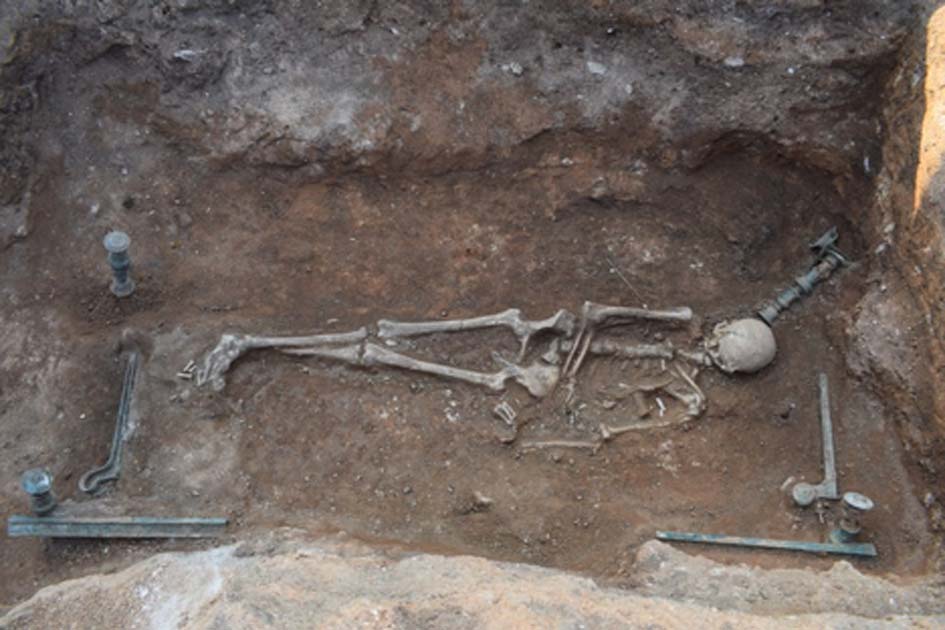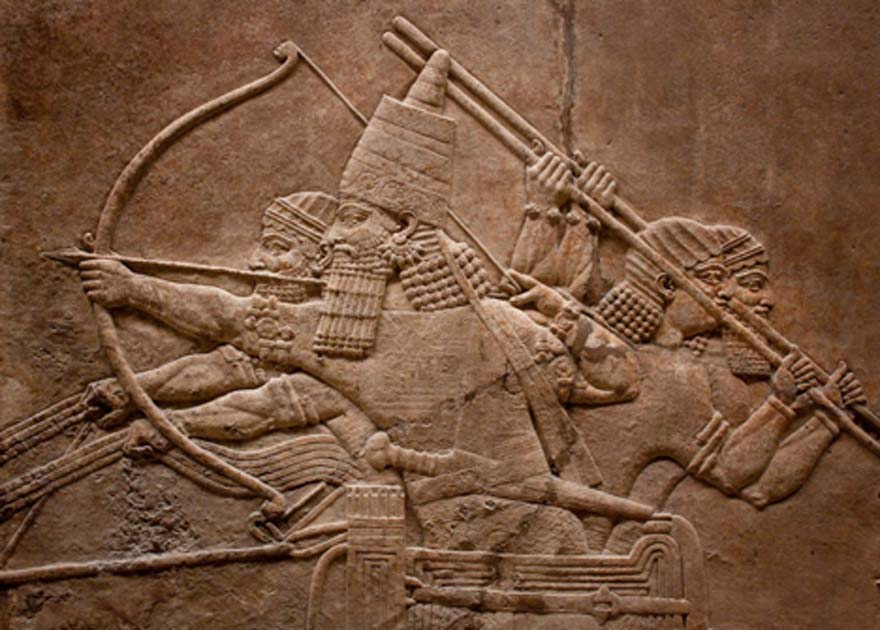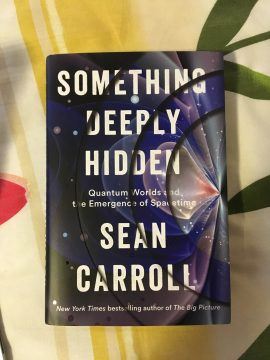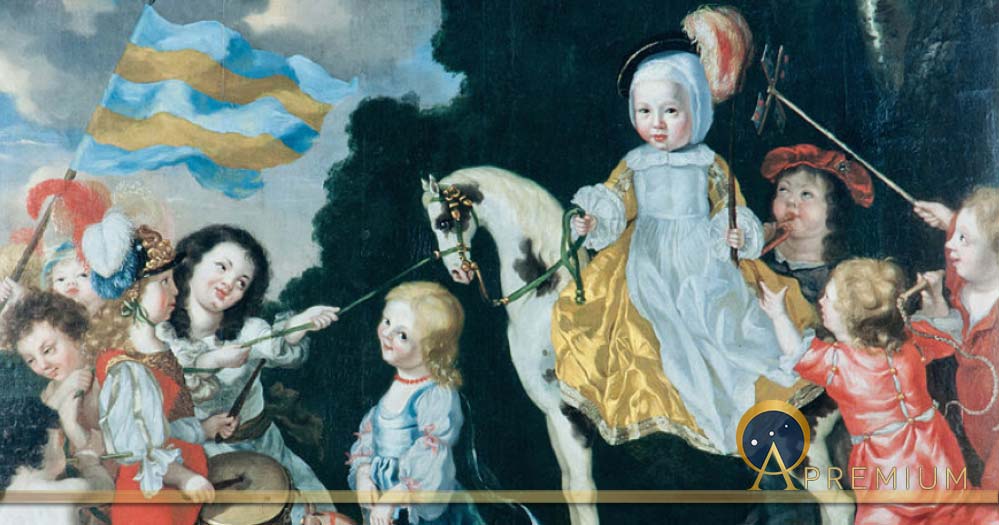via Ancient Origins by Alicia McDermott

The Hellenistic tomb of a woman found in the Kozani region of Greece. Source: Kozani Ephorate of Antiquities
Ancient tombs are fascinating finds, especially when they’re intact. They can provide us with clues on how a person died, social status, burial styles, and funerary rites. The last of these is perhaps the most exciting because it can provide a wealth of knowledge about how our ancestors viewed life and death and what may lay beyond. Let’s see what an intact tomb of a woman who died in the Hellenistic period may say about rituals surrounding death in her time.
Continue reading
==============================
via Arts and Letters Daily: Mary M. Lane in Time Magazine

German-born painter George Grosz working on a satirical painting that depicts Adolf Hitler resting with skeletons at his feet, in studio at home
Time Life Pictures/Getty ImagesWhen Adolf Hitler took charge of Germany 85 years ago this summer [2019], he did not, contrary to popular belief, “seize power”. Rather, Germans elected him their Führer, or leader, in a referendum on Aug. 19, 1934 and subsequently chose to subscribe to the cultural narrative that he created: that Germany had become too open, too tolerant of cultural diversity in the early 20th century. This openness, Hitler argued, had caused their recent national identity crisis.
Hitler knew that to conquer the wounded hearts of a broken citizenry, he must first conquer culture itself. Dozens of artists faced his persecution when he pushed “Degenerate Art” out of museums and into a derisive exhibition in 1937, but very few tried to warn against it through their work.
Continue reading
==============================
via Boing Boing by Carla Sinclair
Continue reading
==============================
via Ancient Origins by Sarah P Young

Mesopotamian relief of Assyrian warriors. Credit: kmiragaya / Adobe Stock
In ancient times, Mesopotamia, meaning ‘land between two rivers’, was a vast region that lay between the Tigris and Euphrates river systems, and it is where civilization emerged over 7,000 years ago. The first inhabitants, the Sumerians, established an advanced system writing, spectacular arts and architecture, astronomy and mathematics. The Akkadians would follow the Sumerians, borrowing from their culture, producing a new language of their own, and creating the world’s first empire.
Mesopotamia corresponds to what is now Iraq, Kuwait, Eastern Syria, Southeast Turkey, and parts of the Turkish-Syrian and Iran-Iraq borders. The region encompassed some of what is known by historians as the ‘ fertile crescent ’. The conditions in the fertile crescent, which also includes the Levantine coast, the Iranian-Iraqi modern border, and significant ancient sites such as Göbekli Tepe and Jericho, made it ideal for agriculture. All eight of the ‘founder’ crops of Neolithic agriculture (the wild forms of emmer wheat, barley, flax, einkorn, pea, lentil, chickpea, and bitter vetch) were found in abundance along with easily domesticated animals (pigs, sheep, cattle, and goats) with horses nearby.
Continue reading
==============================
via Interesting Literature
In this week’s Dispatches from The Secret Library, Dr Oliver Tearle enjoys some vintage science fiction courtesy of The Best of John Wyndham, 1932-1949
I’ve blogged before about my discovery of John Wyndham’s science fiction in a local charity shop, which had a number of old paperbacks for 99p each. That initial book haul yielded, among others, The Seeds of Time, one of a number of short-story collections published by the master of what Brian Aldiss called (perhaps a tad unfairly, if not reductively) the ‘cosy catastrophe’. But John Wyndham had served a long apprenticeship by the time he became a household name in the 1950s thanks to The Seeds of Time, The Midwich Cuckoos, The Chrysalids, The Kraken Wakes, and, first and chief of all, The Day of the Triffids.
The Best of John Wyndham, 1932-1949 showcases the best of John Wyndham’s early stories.
Continue reading
==============================
via The National Archives Blog by Dr Juliette Desplat
Signed on 28 June 1919, the Treaty of Versailles ended the war between Germany and the Allied Powers.
Between the War Guilt Clause and the Financial Clauses, Article 246 stated:
‘Within six months from the coming into force of the present Treaty […], Germany will hand over to His Britannic Majesty’s Government the skull of Sultan Mkwawa which was removed from the Protectorate of British East Africa and taken to Germany.’ (FO 93/36/76)
Continue reading and discover a rather macabre story.
==============================
via 3 Quarks Daily by Ashutosh Jogalekar

For me, a highlight of an otherwise ill-spent youth was reading mathematician John Casti’s fantastic book “Paradigms Lost“. The book came out in the late 1980s and was gifted to my father who was a professor of economics by an adoring student. Its sheer range and humor had me gripped from the first page. Its format is
Continue reading
==============================
via Boing Boing by Seamus Bellamy
Trabzon is a northeastern province of Turkey. You'll find a lot of light industry there: small farmers, plantations growing tea and craftsman. It also happens to be home to some of the most sought-after honey in the world.
Ibrahim Sedef, is a beekeeper who, along with his bees, works in the region, producing Anzer honey. It's aromatic stuff and is wildly believed to have curative powers—your healthcare mileage may vary. People love Sedef's honey. Unfortunately, so do a bunch of local bears.
Sedef tried a number of solutions to keep the animals away from his beehives: he locked the hives up for the night. He secured his home against the animals breaking in. He even left out sweet fruit and baked goods for the bears to draw them away from his products. No dice. Over three years, he lost over $10,000 in profits. At this point, a lot of folks may have turned to having the animals killed, in order to protect their profits. Not Sedef: he enlisted the furry brutes to do a bit of taste testing for him, instead.
==============================
via Interesting Literature
‘When Daisies Pied and Violets Blue’ is a song from Shakespeare’s play Love’s Labour’s Lost. Although it’s easy, because this is a song, to dismiss its meaning as frivolous or the words as ‘nonsense’, it’s worth stopping to analyse the lyrics of the song and their place in the play as a whole. Here’s the text of ‘When Daisies Pied and Violets Blue’ followed by a few words of comment and analysis.
Continue reading
==============================
via Ancient Origins by Ashley Cowie

Children Playing by David Klöcker Ehrenstrahl (1651) Skokloster Castle ( Public Domain )
The main halls and secured vaults of museums around the world are loaded with vast arrays of grotesque antique weapons, golden lined velvet robes, ceremonial swords and crowns, jewel encrusted scepters and other adult treasures and artifacts. Toys, play paraphernalia and games from the most remote past are generally assigned a shelf or a dusty cabinet but kites, balls, yo-yos and stick dolls wrapped in cloth have been discovered across the face of the planet, proving that children’s imaginations have always mimicked real life.
Continue reading
No comments:
Post a Comment